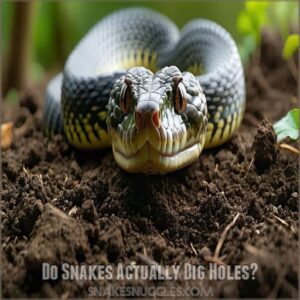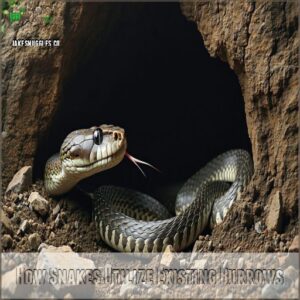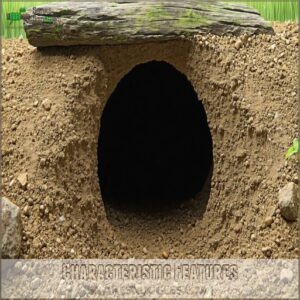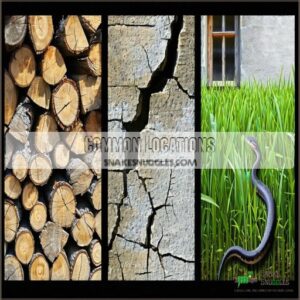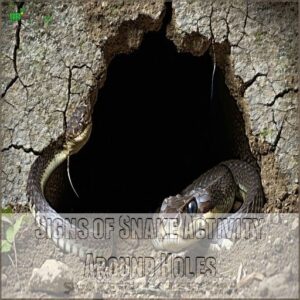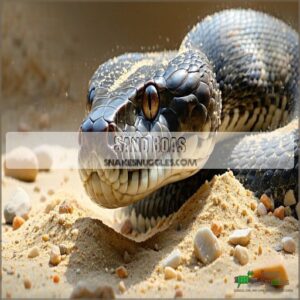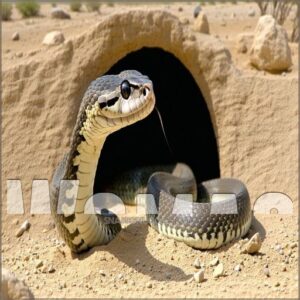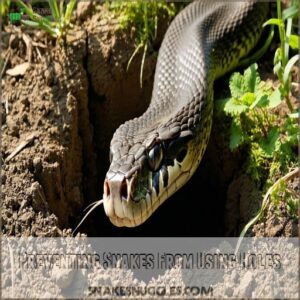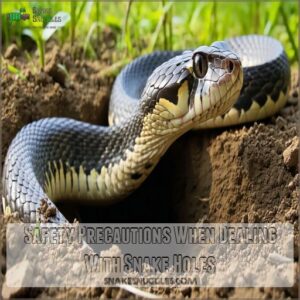This site is supported by our readers. We may earn a commission, at no cost to you, if you purchase through links.
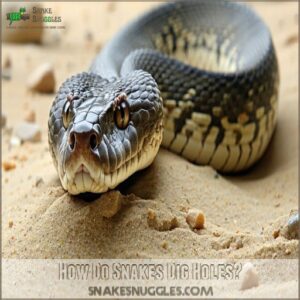
While species like sand boas and black-headed pythons can burrow using their pointed snouts and muscular bodies, they typically occupy existing holes.
You’ll find these sneaky reptiles taking over rodent burrows, using them for shelter and protection. Their flexible bodies and smooth scales help them navigate tight spaces with ease.
Look for circular openings about pencil-width to 4 inches wide, often near rocks or logs. Watch for telltale signs like shed skins and dark, rope-like droppings nearby.
Before you panic, remember: not all snake holes are active, and most snakes prefer borrowing over digging.
Table Of Contents
- Key Takeaways
- How Do Snakes Dig Holes?
- Do Snakes Actually Dig Holes?
- How Snakes Utilize Existing Burrows
- Identifying Snake Holes in Your Yard
- Signs of Snake Activity Around Holes
- Snake Species Known for Burrowing Behavior
- Preventing Snakes From Using Holes
- Safety Precautions When Dealing With Snake Holes
- Frequently Asked Questions (FAQs)
- How do snakes dig holes in the ground?
- How do you know if a snake is digging a hole?
- Do snakes burrow in holes?
- How do snake holes work?
- Are there snake holes in your backyard?
- Do snakes make their own holes?
- How do you tell if a hole is from a snake?
- How do snakes dig a hole in the ground?
- How far down do snakes burrow?
- What does a snake burrow look like?
- Conclusion
Key Takeaways
- You’ll discover that most snakes don’t actually dig their own holes, but instead cleverly occupy existing burrows created by other animals like rodents or small mammals.
- Look for snake holes by checking for clean, circular openings about 2-4 inches wide, typically located near rocks, logs, or in soft ground, with telltale signs like shed skins and distinctive droppings.
- A few specialized snake species, like sand boas and black-headed pythons, can partially burrow, using their muscular bodies and pointed snouts to wiggle through soft soil or sand when necessary.
- You can discourage snakes from using holes in your yard by implementing strategic landscaping techniques like trimming tall grass, removing debris, spreading gravel, and sealing potential entry points around your property.
How Do Snakes Dig Holes?
Though most snakes aren’t known for digging, they’ve mastered the art of using what’s already there.
Some snakes, like sand boas, black-headed pythons, and womas, have honed unique digging techniques. These expert "excavators" use their pointed snouts and powerful muscles to burrow through soft soil or sand—a process more like wiggling than actual digging.
Snakes don’t just dig for the fun of it; burrows serve as shelters, nesting spots, and hiding places from predators. Snake hole sizes can vary but often have smooth edges and measure 2-4 inches wide.
Avoid disturbing these holes; some dangers come with blindly poking around. For persistent issues, consider professional removal.
Want proof of activity? Look for telltale signs like shed skins or snake tracks nearby.
Do Snakes Actually Dig Holes?
You might think snakes are expert diggers, but most rely on burrows made by other animals.
Some exceptions exist, like black-headed pythons, which can maneuver through soft sand to create their own shelters.
Myth Vs. Reality
Ever wondered if snakes are nature’s underground architects? Think again! These slithery strategists aren’t digging their own real estate – they’re professional squatters. Most snakes simply move into pre-existing burrows crafted by other critters, turning abandoned holes into their personal hideouts.
- Snake holes aren’t always what they seem
- Survival trumps construction for these clever reptiles
- Nature’s housing market works differently underground
Rodent tunnels, abandoned mole passages, and forgotten ground squirrel homes become prime snake accommodations. They’re less about excavation and more about opportunistic living. These cold-blooded tenants repurpose existing spaces, using them for shelter, hunting, and protection from predators. It’s a smart survival strategy that challenges the common myth of snakes as underground diggers.
Exceptions to The Rule
While most snakes don’t dig their own holes, some remarkable exceptions prove the rule.
Understanding the importance of proper substrate selection is essential for captive burrowing snakes.
Some snake species have developed extraordinary burrowing skills that challenge our understanding of typical snake behavior.
| Species | Burrowing Ability | Habitat |
|---|---|---|
| Sand Boas | Excellent | Desert/Sandy |
| Black-headed Pythons | Proficient | Arid Regions |
| Womas | Moderate | Sandy Terrain |
| Garter Snakes | Limited | Soft Ground |
| Rat Snakes | Minimal | Forest Floors |
Arboreal snakes occasionally burrow, demonstrating nature’s incredible adaptability in atypical habitats.
How Snakes Utilize Existing Burrows
If you’ve ever wondered how snakes find shelter, you’ll be surprised to learn they’re masters of adaptation.
Most snakes don’t dig their own holes but instead cleverly repurpose existing burrows created by rodents, small mammals, or other ground-dwelling creatures.
Types of Burrows Used
Snakes are master squatters in the animal kingdom, commandeering existing burrows like seasoned real estate opportunists. Their choice of shelter isn’t random but a calculated survival strategy that speaks volumes about their adaptability.
- Burrow locations range from grassy meadows to concrete foundation cracks
- Size and shape vary dramatically based on available spaces
- Entrances remain remarkably clean and debris-free
- Sunlight and food proximity substantially influence selection
Nature has equipped these reptiles with an uncanny ability to identify and occupy the most strategic hiding spots. Underground passages created by rodents, abandoned prairie dog homes, or tiny gaps in rocky terrain become prime snake real estate. These resourceful creatures don’t waste energy digging when perfectly good shelters already exist – it’s nature’s version of finding a ready-made apartment in a competitive housing market.
Reasons for Occupying Holes
Underground tunnels transform into lifelines for serpents seeking shelter and survival.
These burrow networks offer critical protection from harsh environments, providing warmth during cold months and safety from potential predators.
Snakes aren’t master excavators, so they cleverly commandeer existing holes created by rodents, small mammals, and other wildlife. Hibernation demands a strategic retreat, and these snake burrows become sanctuaries where reptiles can conserve energy and escape extreme temperatures.
Their habitat creation strategy is less about digging and more about opportunistic occupation. From narrow crevices to abandoned rodent tunnels, snakes leverage these natural hideouts with remarkable adaptability.
Whether seeking refuge from scorching sun or avoiding hungry predators, these underground spaces represent more than just holes—they’re survival headquarters for cunning reptiles. Underground spaces are lifelines for serpents.
Identifying Snake Holes in Your Yard
If you’ve ever spotted mysterious holes in your yard, you might be wondering whether they belong to a snake.
You’ll want to know the telltale signs of snake holes, from their size and location to the subtle indicators that reveal a serpent’s hidden home.
Characteristic Features
Ever wondered what makes a snake hole stand out? Your backyard detective work starts here! Look for these telltale signs of potential snake real estate:
- Circular openings ranging from pencil-width wide to 4 inches wide
- Shallow depths with minimal excavation
- Entrances near protective cover like rocks or fallen logs
- Distinct soil disturbance patterns matching snake digging methods
Hole size and shape variations reveal nature’s crafty architects, transforming ordinary ground into secret snake sanctuaries with minimal earth-moving effort.
Snakes often exhibit temperature regulation techniques, such as using temperature regulation to control their body heat, transforming ordinary ground into secret snake sanctuaries with minimal earth-moving effort.
Common Locations
Wildlife lovers, buckle up for your ultimate guide to snake hideout hotspots! Serpentine sanctuary locations might surprise you, ranging from unexpected nooks to hidden crannies.
| Location | Risk Level | Likelihood |
|---|---|---|
| Woodpiles | High | Frequent |
| Building Cracks | Medium | Occasional |
| Tall Grass | High | Common |
Peek under rocks near water sources, scan around building foundations, and investigate dense vegetation.
Soft soil conditions and secluded areas create perfect snake burrow environments. Remember, these crafty reptiles are masters of camouflage, blending seamlessly into their surroundings.
Signs of Snake Activity Around Holes
You’ll want to play detective when searching for signs of snake activity around holes in your yard.
Looking for tell-tale evidence like shed snake skins and distinctive droppings can help.
Dark brown feces with white ends, along with dry, translucent skin remnants near potential burrow entrances, can reveal a snake’s recent presence.
Without you ever seeing the reptile itself, this evidence is key.
Shed Skins and Feces
Spotting snake activity isn’t just about holes—it’s a forensic investigation of serpent secrets! When you’re searching for signs of snake habitation, look for two telltale clues: shed skins and distinctive feces, and consider using a snake shed skin finder to help with species identification.
Here’s what to watch for:
- Translucent, ghostly snake skins draped near burrow entrances
- Dark, rope-like droppings with distinctive white uric acid caps
- Shed skin patterns that hint at species identification
- Fecal decay rates that reveal recent snake presence
Fecal analysis can be your secret weapon in snake habitat detection. These biological calling cards reveal more than you’d expect—they’re nature’s own forensic evidence of snake digging behavior and burrow hide locations. Your yard might be hosting more slithery residents than you realized!
Tracks and Markings
After discovering shed snake skins, tracking their movements becomes your next investigative challenge. Snake trails reveal hidden secrets in soft terrain, stories of recent reptilian journeys often occurring in diverse environments such as tropical regions with high snake biodiversity.
| Tracking Method | Difficulty | Reliability |
|---|---|---|
| Soil Imprints | Moderate | High |
| Grass Patterns | Low | Medium |
| Scent Markers | High | Low |
| Visual Traces | Low | Medium |
Professional snake experts recommend careful observation without direct interaction. Look for subtle disturbances in soil, barely-visible trail marks, and camouflaged entry points. Understanding how snakes dig and burrow, most snake holes blend seamlessly with their surroundings, making identification a test of your wildlife tracking skills.
Snake Species Known for Burrowing Behavior
If you’re wondering which snake species are true experts at creating underground homes, you’ll be surprised to learn that only a few specialized serpents have mastered the art of burrowing.
Sand boas, black-headed pythons, and womas stand out as nature’s most adept subterranean architects, using their unique body structures to navigate and create intricate tunnels in soft, yielding terrain.
Sand Boas
Ever wonder how sand boas become nature’s underground architects? These remarkable serpents use their shovel-shaped snouts to excavate intricate tunnels, transforming loose soil into complex homes and hunting grounds.
- Masters of underground navigation
- Specialized snout for precise digging
- Create elaborate tunnel networks
- Exceptional prey capture strategy
- Unique reproductive adaptations
Sand boas represent a fascinating example of snake burrowing expertise, revealing nature’s ingenious survival techniques through their remarkable excavation skills.
Black-headed Pythons
Curious how black-headed pythons master their underground world?
These Australian serpents are burrowing champions, wielding muscular bodies to excavate sandy terrains like underground architects.
Their remarkable digging techniques showcase nature’s ingenious snake body mechanics, transforming arid landscapes into intricate tunnel networks.
Black-headed pythons use specialized digging tools, like burrowing snake kits, to efficiently construct their underground habitats.
These pythons aren’t just surviving—they’re engineering their own subterranean kingdoms.
Womas
Meet the womas: Australia’s desert-dwelling python masters of underground living. These serpents aren’t just hiding—they’re engineering survival with incredible precision. Their burrowing skills showcase nature’s adaptive genius: they’ve adapted to diverse environments, including deserts and rocky outcrops.
- Sculpt intricate underground networks in arid landscapes
- Hunt small mammals through hidden desert corridors
- Create multi-entrance burrows for rapid escape routes
- Leverage muscular bodies to excavate sandy terrain
With specialized Woma diet and habitat strategies, these pythons transform harsh desert environments into complex, living sanctuaries.
Preventing Snakes From Using Holes
You’ll want to take proactive steps to discourage snakes from using holes in your yard, starting with understanding their habitat preferences and potential entry points.
By implementing strategic landscaping techniques and sealing potential access areas, you can substantially reduce the likelihood of snakes establishing burrows on your property.
Landscaping Techniques
After exploring burrowing snake species, let’s turn our attention to your yard’s defense strategy.
Smart landscaping can transform your outdoor space into a snake-deterrent zone.
Trim back tall grass, remove brush piles, and clear debris that offers hidden refuges. Strategic plant choices like marigolds and lemongrass create natural barriers snakes avoid.
Spread gravel or rough mulch types around your property’s perimeter – these surfaces discourage slithering intruders.
By modifying your habitat thoughtfully, you’ll make your yard less attractive to snake holes and unwelcome reptilian guests. Your landscape becomes a strategic shield against potential snake invasions.
Sealing Entry Points
Once you’ve mapped out potential snake entry points, it’s time to fortify your property.
Gravel and expand-foam work wonders for filling burrow shapes, while wire mesh and hardware cloth create impenetrable barriers around foundations.
Scent deterrents like cinnamon and clove oils add an extra layer of snake defense.
Keep grass trimmed short and clear away ground cover that might invite unwelcome slithery guests.
Understanding why snakes hide, particularly their preference for natural cover, is key to effectively sealing those sneaky cracks in walls and concrete – think of it as snake-proofing your home’s immune system against these crafty reptilian intruders.
Safety Precautions When Dealing With Snake Holes
When exploring potential snake holes, you’ll want to arm yourself with knowledge and caution to guarantee your safety.
Understanding the right protective gear and approach can mean the difference between a harmless encounter and a potentially dangerous situation.
Proper Handling Techniques
When dealing with snake holes, understanding proper handling techniques is essential for your safety. Here are four key strategies for snake encounter management:
- Wear thick protective gloves and long pants
- Keep a safe distance from any potential snake holes
- Use long-handled tools for investigation
- Never attempt to handle snakes directly
Snake encounters demand respect and caution. Most snake species will avoid human contact if given the opportunity, but they’ll defend themselves when threatened. Your primary goal should be minimizing risk through careful observation and avoiding direct interaction. Identifying the snake species from a safe distance can provide critical insights into potential behaviors and risks. Remember, even non-venomous snakes can deliver painful bites when feeling cornered or scared.
When to Call a Professional
If you’re facing venomous snakes or repeated sightings in your yard, it’s time to wave the white flag and call in the professionals.
Wildlife removal experts are your best bet when dealing with unidentified species or unsafe removal attempts.
They’ve got the skills to handle snake control with precision and care, ensuring both human and serpent safety.
A professional can quickly assess nest discoveries, identify potential entry points, and develop a thorough strategy for managing snake holes in your yard.
Don’t play hero—these specialists have the right tools, knowledge, and experience to tackle even the most challenging snake scenarios safely and humanely.
Frequently Asked Questions (FAQs)
How do snakes dig holes in the ground?
Snakes don’t typically dig their own holes; they use existing burrows from rodents or other animals.
However, species like black-headed pythons and sand boas can partially excavate soft substrates, such as loose soil or sand, for shelter.
How do you know if a snake is digging a hole?
You’ll spot snake holes by their clean, debris-free entrances near soft ground, often without cobwebs.
Look for mysterious oval-shaped openings in yards, around logs, or near structures where snakes might seek shelter.
Do snakes burrow in holes?
Like a treasure hunter seeking shelter, some snakes burrow in holes created by other animals.
They don’t typically dig their own, preferring existing underground spaces for safety, warmth, and protection from predators.
How do snake holes work?
Discover underground hideouts where serpents seek refuge!
Most holes aren’t dug by snakes themselves but borrowed from other critters.
Offering shelter, warmth, and protection in soft soil or hidden nooks across diverse landscapes.
Are there snake holes in your backyard?
Creepy, quiet, hidden—snake holes might lurk in your yard’s shadows.
Check tall grasses, woodpiles, and garden edges.
Soft soil and debris attract these slithering residents, potentially harboring non-venomous species that help control rodent populations.
Do snakes make their own holes?
Snakes typically don’t dig their own holes.
They’re opportunistic squatters, using burrows created by other animals or natural crevices.
Most snake species rely on existing underground spaces for shelter, protection, and temperature regulation. This is because existing underground spaces provide ideal conditions for snakes.
How do you tell if a hole is from a snake?
Look for round or oval holes about 2-4 inches wide near soft soil, logs, or rocks.
Check for snake shed skin.
Check for dark droppings with white ends.
Check for no cobwebs or debris at the entrance.
How do snakes dig a hole in the ground?
Think of it like a stealthy excavation.
Most snakes don’t dig their own holes but instead repurpose soft soil or animal burrows.
Species like garter or rat snakes may loosen soil, but true digging is rare.
How far down do snakes burrow?
You’ll find most snakes burrow just inches deep, typically 2-6 inches underground.
Depending on species and environment, some can dig up to a foot down, creating temporary shelters for protection and temperature regulation.
What does a snake burrow look like?
Like nature’s hidden architects, snake burrows are small, oval-shaped openings in soft earth, typically without debris.
They’re camouflaged portals measuring 2-4 inches wide, often nestled near vegetation, logs, or rocky areas.
snake burrows are where snakes seek shelter.
Conclusion
Ever wonder how snakes dig holes? The truth is, most don’t—they’re expert opportunists!
Using rodent burrows, they avoid the hassle of digging, relying on smooth scales and flexible bodies to move in with ease.
While exceptions like sand boas can burrow, most snakes prefer the ready-made option.
Keep an eye out for telltale signs like shed skin or droppings if you suspect snake activity.
Understanding their behavior keeps you informed and your space snake-free.

